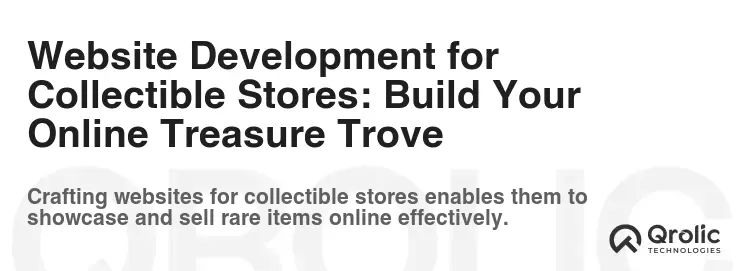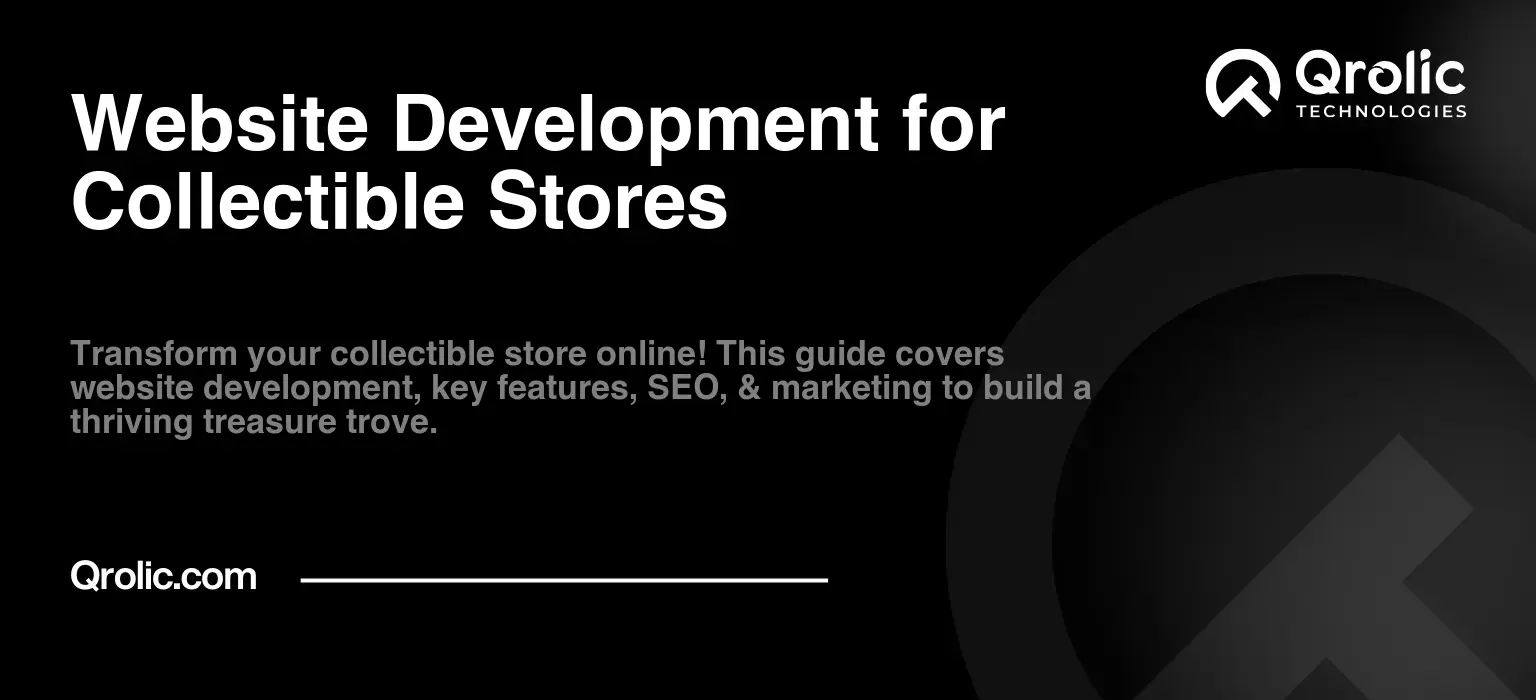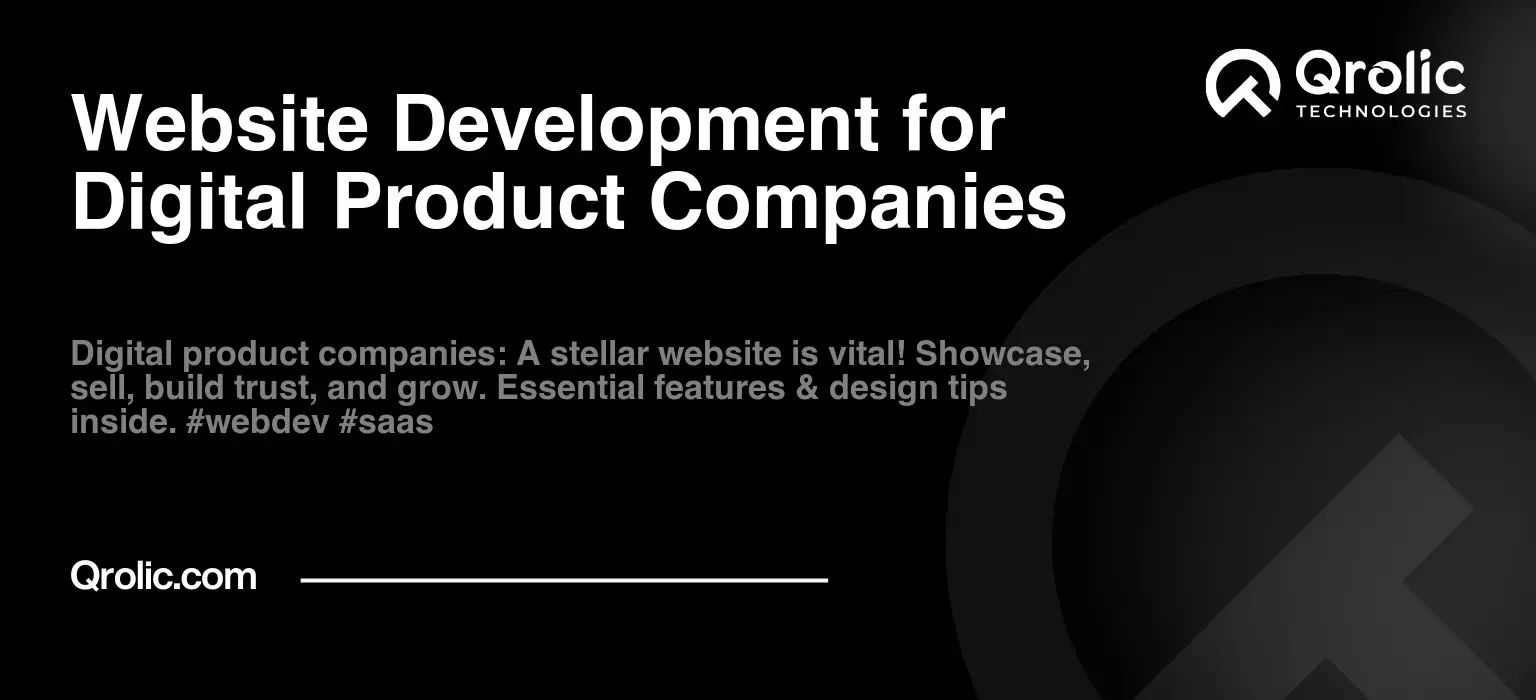Quick Summary:
- Expand global reach and sell 24/7 online.
- Use high-quality photos and detailed descriptions.
- Optimize your site for search and effective marketing.
- Always disclose item condition and legal details.
Table of Contents
- Website Development for Collectible Stores: Build Your Online Treasure Trove
- I. Why Your Collectible Store Needs a Stellar Website
- A. Expanding Your Reach Beyond Local Borders
- B. 24/7 Accessibility: Selling While You Sleep
- C. Showcasing Your Expertise and Building Trust
- D. Streamlining Inventory Management
- E. Targeted Marketing and Increased Sales
- II. Key Features of a Successful Collectible Store Website
- A. High-Quality Product Photography
- B. Detailed and Accurate Product Descriptions
- C. Robust Search and Filtering Functionality
- D. Secure and User-Friendly E-Commerce Platform
- E. Mobile Responsiveness: Reaching Collectors On the Go
- F. Customer Reviews and Testimonials: Building Social Proof
- G. Integrated Blog and Content Marketing Strategy
- H. Community Features: Fostering Engagement and Loyalty
- I. Inventory Management System (IMS) Integration
- III. The Development Process: From Concept to Launch
- A. Planning and Requirements Gathering
- B. Design and User Experience (UX)
- C. Development and Programming
- D. Testing and Quality Assurance (QA)
- E. Launch and Deployment
- F. Maintenance and Updates
- IV. SEO Strategies for Collectible Stores
- A. Keyword Research: Unlocking the Language of Collectors
- B. On-Page Optimization: Making Your Website Search-Engine Friendly
- C. Content Marketing: Attracting and Engaging Your Audience
- D. Link Building: Building Authority and Credibility
- E. Local SEO: Reaching Local Collectors
- V. Marketing Your Collectible Store Website
- A. Social Media Marketing: Connecting with Collectors
- B. Email Marketing: Nurturing Leads and Driving Sales
- C. Paid Advertising: Reaching a Wider Audience
- D. Partnerships and Collaborations: Expanding Your Reach
- VI. Qrolic Technologies: Your Partner in Collectible Store Website Development
- VII. Legal Considerations for Selling Collectibles Online
- A. Authenticity and Provenance
- B. Grading and Condition Disclosure
- C. Copyright and Intellectual Property
- D. Sales Tax and Shipping Regulations
- E. Return Policies and Dispute Resolution
- VIII. The Future of Collectible Store Websites: Trends to Watch
- A. Augmented Reality (AR) and Virtual Reality (VR)
- B. Personalized Recommendations
- C. Live Streaming and Auctions
- D. Blockchain Technology and NFTs
- E. Sustainable and Ethical Sourcing
- IX. Final Thoughts: Building a Legacy
Website Development for Collectible Stores: Build Your Online Treasure Trove

Welcome fellow collectors and business owners! In today’s digital age, having a robust online presence is no longer optional; it’s essential for survival and growth. This is particularly true for collectible stores, where passionate enthusiasts are constantly searching for that elusive missing piece, that perfect investment, or that nostalgic reminder of a cherished memory. This comprehensive guide will delve into the world of collectible store website development, covering everything from the fundamental building blocks to advanced strategies that will transform your online store into a thriving hub for collectors worldwide.
I. Why Your Collectible Store Needs a Stellar Website
Before diving into the “how,” let’s solidify the “why.” Why invest in a well-developed website for your collectible store? The answer is multifaceted, offering tangible benefits that directly impact your bottom line.
A. Expanding Your Reach Beyond Local Borders
Your physical store is limited by geography. A website transcends those limitations, opening your doors to a global marketplace. Collectors from across the country, or even across the globe, can discover your unique offerings. Imagine reaching a collector in Japan searching for a rare vintage toy you happen to have in stock! That’s the power of a website.
B. 24/7 Accessibility: Selling While You Sleep
Unlike your brick-and-mortar store with its set operating hours, your website is open for business 24 hours a day, 7 days a week, 365 days a year. Customers can browse your inventory, place orders, and connect with you at their convenience, regardless of time zones. This continuous availability translates to increased sales and customer satisfaction.
C. Showcasing Your Expertise and Building Trust
A website allows you to present yourself as an expert in your niche. Through detailed product descriptions, informative blog posts, and engaging videos, you can educate your audience, build trust, and establish your credibility as a reliable source for collectibles. This expertise fosters loyalty and encourages repeat business.
D. Streamlining Inventory Management
A well-integrated website facilitates efficient inventory management. By tracking sales, monitoring stock levels, and automating updates, you can minimize errors, optimize your inventory, and avoid overselling. This streamlined process saves you time and money, allowing you to focus on other aspects of your business.
E. Targeted Marketing and Increased Sales
With a website, you can leverage powerful digital marketing techniques to reach your target audience. Search Engine Optimization (SEO) ensures your website ranks high in search results, while social media marketing allows you to connect with collectors on their favorite platforms. Targeted email campaigns can promote new arrivals, special offers, and upcoming events, driving traffic and boosting sales.
II. Key Features of a Successful Collectible Store Website
Now that we understand the importance of a website, let’s explore the essential features that contribute to its success.
A. High-Quality Product Photography
In the world of collectibles, visuals are paramount. Potential buyers need to see the item in detail to assess its condition, authenticity, and overall appeal. Invest in professional photography that captures the nuances of each item, showcasing its unique features and highlighting its value. Consider using multiple angles and zoom capabilities to provide a comprehensive view.
B. Detailed and Accurate Product Descriptions
Beyond visual appeal, accurate and informative product descriptions are crucial. Provide comprehensive details about the item, including its history, condition, rarity, dimensions, and any relevant provenance. Use descriptive language that appeals to collectors, evoking a sense of nostalgia, excitement, or exclusivity. Don’t forget to include keywords that collectors are likely to use when searching for specific items.
- Example: Instead of simply stating “Vintage Baseball Card,” try “1952 Topps Mickey Mantle Baseball Card (PSA 7) – A cornerstone of any serious baseball card collection. This iconic card is in excellent condition for its age, exhibiting sharp corners and vibrant colors. Graded PSA 7 (Near Mint), it represents a significant investment opportunity.”
C. Robust Search and Filtering Functionality
With a potentially vast inventory, a robust search and filtering system is essential. Allow users to easily find what they’re looking for by implementing advanced search filters based on categories, brands, era, condition, price range, and other relevant criteria. This ensures a seamless and efficient browsing experience.
D. Secure and User-Friendly E-Commerce Platform
Choose a secure and reliable e-commerce platform that facilitates smooth and secure transactions. Ensure your website is PCI compliant to protect customer data and build trust. The checkout process should be intuitive and straightforward, minimizing friction and maximizing conversions. Offer a variety of payment options to cater to different customer preferences.
E. Mobile Responsiveness: Reaching Collectors On the Go
In today’s mobile-first world, your website must be fully responsive, adapting seamlessly to different screen sizes and devices. Many collectors browse and purchase items on their smartphones and tablets, so a mobile-friendly website is crucial for capturing these potential sales.
F. Customer Reviews and Testimonials: Building Social Proof
Positive customer reviews and testimonials are powerful tools for building trust and credibility. Encourage customers to leave reviews after their purchases, and prominently display them on your website. Authentic feedback from satisfied customers can significantly influence purchasing decisions.
G. Integrated Blog and Content Marketing Strategy
Establish your expertise and attract new customers by creating a blog that provides valuable content related to your collectibles. Share informative articles, historical insights, collecting tips, and industry news. This content not only educates your audience but also improves your website’s search engine ranking, driving organic traffic to your store.
-
Example Blog Post Topics:
- “The Ultimate Guide to Grading Comic Books”
- “Investing in Rare Coins: A Beginner’s Guide”
- “The History of Vintage Star Wars Action Figures”
H. Community Features: Fostering Engagement and Loyalty
Consider incorporating community features into your website, such as a forum, a chat room, or a social media integration. These features allow collectors to connect with each other, share their knowledge, and discuss their passions. Building a community around your brand fosters loyalty and encourages repeat business.
I. Inventory Management System (IMS) Integration
Integrating an IMS is vital for accuracy. It connects your online store with your physical inventory and accounting, ensuring that stock levels are accurate and preventing overselling.
III. The Development Process: From Concept to Launch
Creating a successful collectible store website involves a systematic development process, typically involving the following stages:
A. Planning and Requirements Gathering
This initial stage involves defining your goals, target audience, budget, and desired features. Conduct market research to identify your competitors and understand industry trends. Create a detailed project plan outlining the scope, timeline, and deliverables. Choose a domain name that is memorable, relevant, and easy to spell.
B. Design and User Experience (UX)
The design phase focuses on creating a visually appealing and user-friendly website. Choose a design aesthetic that reflects your brand and resonates with your target audience. Prioritize a clean, intuitive layout that makes it easy for users to navigate your website and find what they’re looking for. Ensure the website is accessible to users with disabilities.
C. Development and Programming
The development stage involves translating the design into functional code. Choose a suitable e-commerce platform, such as Shopify, WooCommerce, or Magento, and customize it to meet your specific needs. Integrate essential features, such as product catalog management, shopping cart functionality, payment gateway integration, and shipping options.
D. Testing and Quality Assurance (QA)
Thorough testing is crucial to ensure your website is free of errors and functions flawlessly. Test all features and functionalities, including the search function, checkout process, and payment gateway integration. Test the website on different browsers, devices, and operating systems to ensure cross-platform compatibility.
E. Launch and Deployment
Once the testing is complete and all issues have been resolved, it’s time to launch your website. Choose a reliable web hosting provider and deploy your website to their servers. Monitor your website closely after launch to identify and address any unforeseen issues.
F. Maintenance and Updates
A website is not a static entity; it requires ongoing maintenance and updates to ensure its security, performance, and functionality. Regularly update your website’s software, plugins, and themes to patch security vulnerabilities and improve performance. Continuously monitor your website’s analytics to identify areas for improvement.
IV. SEO Strategies for Collectible Stores
Having a beautiful and functional website is only half the battle. You also need to ensure that potential customers can find your website through search engines like Google. This requires a well-defined SEO strategy.
A. Keyword Research: Unlocking the Language of Collectors
Keyword research is the foundation of any successful SEO strategy. Identify the keywords that collectors are likely to use when searching for specific items. Use tools like Google Keyword Planner, Ahrefs, or SEMrush to discover relevant keywords with high search volume and low competition.
-
Example Keywords:
- “Vintage comic books for sale”
- “Rare coins online”
- “Antique toys near me”
- “Collectible sports memorabilia”
- “Graded baseball cards”
- “Funko Pop collectibles”
- “Memorabilia web design”
- “Collectible store website development”
- “Specialty retail website design”
B. On-Page Optimization: Making Your Website Search-Engine Friendly
On-page optimization involves optimizing your website’s content and structure to improve its ranking in search results. This includes:
- Title Tags and Meta Descriptions: Craft compelling title tags and meta descriptions that accurately describe your website’s content and entice users to click.
- Header Tags (H1, H2, H3): Use header tags to structure your content and highlight important keywords.
- Image Alt Text: Add descriptive alt text to all images, using relevant keywords.
- Internal Linking: Link to other relevant pages on your website to improve navigation and distribute link juice.
- URL Structure: Create clean and descriptive URLs that include relevant keywords.
C. Content Marketing: Attracting and Engaging Your Audience
Content marketing is a powerful SEO strategy that involves creating and distributing valuable, relevant, and consistent content to attract and engage your target audience. This can include blog posts, articles, videos, infographics, and other types of content.
D. Link Building: Building Authority and Credibility
Link building involves acquiring links from other reputable websites. These links act as “votes of confidence” from other websites, signaling to search engines that your website is a valuable resource. Focus on earning high-quality backlinks from relevant websites in the collectibles industry.
E. Local SEO: Reaching Local Collectors
If you have a physical store, local SEO is crucial for attracting local customers. Claim your Google My Business listing and optimize it with accurate information, including your address, phone number, website, and hours of operation. Encourage customers to leave reviews on your Google My Business listing.
V. Marketing Your Collectible Store Website
Once your website is live and optimized for search engines, you need to actively promote it to attract visitors and drive sales.
A. Social Media Marketing: Connecting with Collectors
Social media platforms like Facebook, Instagram, and Twitter are excellent channels for connecting with collectors and promoting your website. Share engaging content, run contests and giveaways, and interact with your followers.
B. Email Marketing: Nurturing Leads and Driving Sales
Email marketing is a cost-effective way to nurture leads, promote new arrivals, and drive sales. Build an email list by offering a valuable incentive, such as a discount code or a free ebook. Segment your email list based on customer interests and send targeted emails.
C. Paid Advertising: Reaching a Wider Audience
Paid advertising, such as Google Ads and social media ads, can help you reach a wider audience and drive targeted traffic to your website. Create compelling ad copy and target your ads to specific demographics, interests, and keywords.
D. Partnerships and Collaborations: Expanding Your Reach
Partner with other businesses in the collectibles industry, such as auction houses, appraisers, and collector clubs, to expand your reach and promote your website to a wider audience.
VI. Qrolic Technologies: Your Partner in Collectible Store Website Development
At Qrolic Technologies, we understand the unique needs of collectible store owners. We offer a comprehensive range of collectible store website development services, including:
- Custom Website Design and Development: We create visually appealing and user-friendly websites that are tailored to your brand and target audience.
- E-Commerce Platform Integration: We integrate leading e-commerce platforms, such as Shopify, WooCommerce, and Magento, to facilitate smooth and secure online transactions.
- Inventory Management System (IMS) Integration: We integrate your website with your IMS to ensure accurate stock levels and prevent overselling.
- SEO Optimization: We optimize your website for search engines to improve its ranking and drive organic traffic.
- Content Marketing: We create engaging and informative content that attracts and engages your target audience.
- Ongoing Maintenance and Support: We provide ongoing maintenance and support to ensure your website remains secure, functional, and up-to-date.
- Memorabilia web design
- Specialty retail website design
Our team of experienced developers, designers, and marketers is passionate about helping collectible stores succeed online. We work closely with our clients to understand their goals and develop customized solutions that deliver results. Contact us today to learn more about how we can help you build a thriving online presence for your collectible store.
VII. Legal Considerations for Selling Collectibles Online
Selling collectibles online isn’t just about showcasing your products; it involves navigating a few legal waters. Here are some critical considerations:
A. Authenticity and Provenance
Clearly state the authenticity of your items. If you have certificates of authenticity, display them prominently. For higher-value items, providing a clear provenance (history of ownership) can significantly boost buyer confidence and justify the price. Be prepared to provide documentation if requested.
B. Grading and Condition Disclosure
Grading standards vary depending on the collectible type (coins, cards, comics). Use established grading systems (e.g., PSA, NGC) and clearly disclose the condition of your items using objective and descriptive language. Avoid subjective terms like “mint” without backing them up with a recognized grading score. Provide high-quality images that clearly show any flaws or imperfections.
C. Copyright and Intellectual Property
Be mindful of copyright and intellectual property rights, especially when dealing with licensed collectibles (e.g., Star Wars, Disney). Ensure you are not infringing on any trademarks or copyrights. If you are selling reproductions, clearly state that they are not original items.
D. Sales Tax and Shipping Regulations
Understand the sales tax laws in your state and any states where you have a significant number of customers. You may need to collect and remit sales tax. Also, be aware of shipping regulations for certain items, such as hazardous materials or items requiring special handling.
E. Return Policies and Dispute Resolution
Clearly state your return policy on your website. Be transparent about the conditions under which returns are accepted and the process for requesting a return. Consider offering a reasonable return window to build trust with customers. Also, establish a clear process for resolving disputes, such as mediation or arbitration.
VIII. The Future of Collectible Store Websites: Trends to Watch
The world of e-commerce is constantly evolving, and collectible stores must stay ahead of the curve to remain competitive. Here are some key trends to watch:
A. Augmented Reality (AR) and Virtual Reality (VR)
AR and VR technologies offer exciting possibilities for enhancing the online shopping experience for collectibles. Imagine allowing customers to virtually “hold” and examine a rare coin in 3D before making a purchase.
B. Personalized Recommendations
Leverage data analytics to provide personalized product recommendations based on customer browsing history, purchase history, and interests. This can increase sales and improve customer satisfaction.
C. Live Streaming and Auctions
Live streaming platforms are becoming increasingly popular for selling collectibles. Host live auctions where collectors can bid on items in real-time, creating a sense of excitement and urgency.
D. Blockchain Technology and NFTs
Blockchain technology and NFTs (Non-Fungible Tokens) are revolutionizing the collectibles industry. NFTs can be used to verify the authenticity and ownership of digital collectibles, creating new opportunities for collectors.
E. Sustainable and Ethical Sourcing
As consumers become more environmentally conscious, there is a growing demand for sustainably and ethically sourced collectibles. Highlight the eco-friendly aspects of your products and your commitment to ethical sourcing practices.
IX. Final Thoughts: Building a Legacy
Building a successful online collectible store is a marathon, not a sprint. It requires careful planning, consistent effort, and a passion for the world of collectibles. By implementing the strategies outlined in this guide, you can create a thriving online business that connects you with collectors around the world and preserves the legacy of these cherished items for generations to come. Good luck, and happy collecting!









